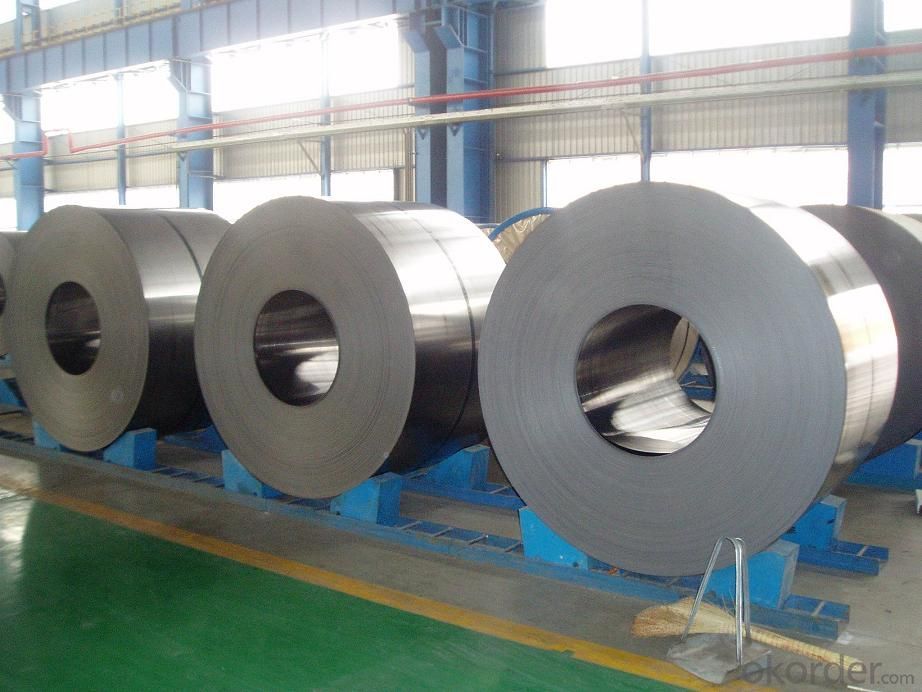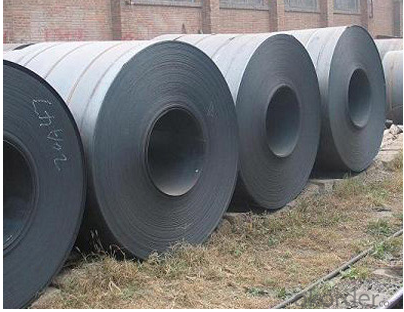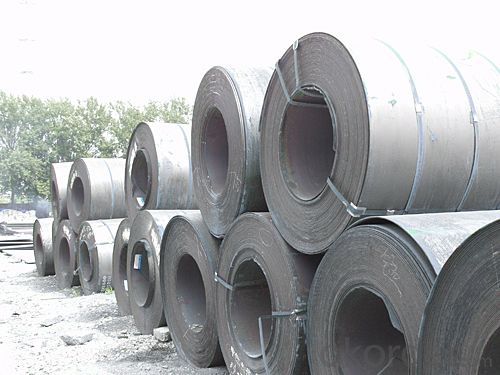Hot- rolled steel coil for construction GB Q235
- Loading Port:
- Tianjin
- Payment Terms:
- TT OR LC
- Min Order Qty:
- 25 m.t.
- Supply Capability:
- 100000 m.t./month
OKorder Service Pledge
OKorder Financial Service
You Might Also Like
Product Description:
One, introduction
Hot rolled coil is used for continuous casting slab or slab as raw material, after reheating furnace heating, scales entered the roughing mill in the high pressure water, roughing cut is expected by the head, tail, and then enter the finishing mill, the implementation of the computer controlled rolling, finally after rolling through the laminar cooling (computer controlled cooling rate) and coiling machine coiling, become straight hair volume. Hair straightener roll head, tail often forms a tongue shape and fishtail, thickness, width of poor accuracy, edge has wavy, folding, tower and other defects. The volume weight heavier, steel coil diameter is 760mm. (general pipe industry like use. )
2 two, characteristics
Because there is no after annealing treatment, the hardness is very high (HRB greater than 90), mechanical processing performance is poor, only a simplebending process has less than 90 degree directional (direction perpendicular to the rolled).
Three, use 3
Hot rolled products with high strength and good toughness, easy processing and good forming can be excellent performance of welding, which is widely used in ships, cars, bridges, buildings, machinery, boiler, pressure vesselmanufacturing industry.
The scope of application:
(1) after annealing processing into the common cold;
(2) processing galvanized galvanized unit before the annealing treatment;
(3) the basic do not need to process the panel.
4 four, classification
Carbon steel plate, carbon plate, low alloy plate, ship plate, bridge plate, boiler plate, container plate etc.. Rolling hard volumes: under normal temperature,the hot pickling volumes of continuous rolling.
Hot rolled steel strip products include steel (roll) and the shear of steel plate.And steel (coils) can be divided into straight and finishes volume (the volume,smooth rolling and slitting roll).



- Q:What are the different types of steel wire rod coating processes?
- There are several different types of steel wire rod coating processes used in the industry. These processes are designed to provide various levels of protection and enhance the performance of the wire rod in different applications. Some of the commonly used coating processes include: 1. Galvanizing: This process involves coating the steel wire rod with a layer of zinc. Galvanizing provides excellent corrosion resistance and is widely used in outdoor applications where the wire is exposed to harsh weather conditions. 2. Phosphate coating: Phosphate coating is a chemical process that involves treating the surface of the steel wire rod with phosphate compounds. This coating enhances the adhesion of subsequent coatings, such as paint or powder coating, and improves corrosion resistance. 3. Electroplating: In electroplating, a thin layer of metal, such as chromium or nickel, is deposited onto the surface of the steel wire rod using an electric current. This process provides improved corrosion resistance and enhances the appearance of the wire rod. 4. Polymer coating: Polymer coating involves applying a layer of polymer material, such as PVC or polyethylene, onto the surface of the steel wire rod. This coating provides protection against corrosion, abrasion, and chemical exposure, making it suitable for a wide range of applications. 5. Epoxy coating: Epoxy coating is a type of polymer coating that utilizes epoxy resin to provide a durable and corrosion-resistant layer on the steel wire rod. This coating is commonly used in applications where high chemical resistance and mechanical strength are required. 6. Aqueous film forming foam (AFFF) coating: AFFF coating is primarily used in the steel wire rod for fire-resistant applications. It forms a thin layer of foam on the surface, which acts as a barrier against heat and fire, providing protection to the wire rod. It is important to select the appropriate coating process based on the specific requirements of the application to ensure optimal performance and longevity of the steel wire rod.
- Q:What are the different types of steel wire rod surface cleaning methods for wire galvanizing flux?
- There are several types of steel wire rod surface cleaning methods used for wire galvanizing flux. These include mechanical cleaning methods such as abrasive blasting or shot blasting, chemical cleaning methods like pickling or acid cleaning, and electrolytic cleaning methods. Each method has its own advantages and suitability depending on the specific requirements and condition of the steel wire rod.
- Q:How is steel wire rod used in the production of suspension springs for railway vehicles?
- Steel wire rod is used in the production of suspension springs for railway vehicles as it provides the necessary strength and durability required to withstand the heavy loads and constant vibrations experienced in rail operations. The steel wire rod is first shaped and coiled into the desired spring design, ensuring proper tension and flexibility. These suspension springs are then integrated into the suspension system of railway vehicles, helping to absorb shocks, maintain stability, and provide a smooth and comfortable ride for passengers and cargo.
- Q:What are the main factors affecting the market innovation of steel wire rod?
- The main factors affecting the market innovation of steel wire rod include technological advancements in manufacturing processes, changes in consumer demand and preferences, competition within the industry, government regulations and policies, and the availability and cost of raw materials.
- Q:How is steel wire rod used in the manufacturing of wire forms for elevator cables?
- Steel wire rod is used in the manufacturing of wire forms for elevator cables as it serves as the primary material for creating the strong and durable wires that make up the cables. The steel wire rod goes through a series of processes such as drawing, annealing, and stranding to form the individual wires. These wires are then twisted or braided together to create the wire forms that provide the necessary strength and flexibility for elevator cables to support the heavy loads and ensure safe and reliable transportation.
- Q:What are the different types of steel wire rod coatings used for abrasion resistance?
- There are several types of steel wire rod coatings used for abrasion resistance, including zinc coatings, epoxy coatings, polyurethane coatings, and ceramic coatings. These coatings help to protect the steel wire rod from wear, friction, and other forms of abrasive damage, thereby increasing its durability and lifespan.
- Q:What are the main factors affecting the market forecasts of steel wire rod?
- The main factors affecting the market forecasts of steel wire rod include global economic conditions, demand and supply dynamics, raw material prices, government policies and regulations, technological advancements, competition within the industry, and geopolitical factors.
- Q:What are the common methods used to protect steel wire rod from corrosion?
- There exist multiple common approaches utilized for safeguarding steel wire rods against corrosion. These approaches consist of: 1. Galvanization: By applying a layer of zinc to the surface of the steel wire rod, galvanization acts as a sacrificial anode. This implies that when exposed to moisture or other corrosive elements, the zinc layer corrodes instead of the steel. 2. Coating: Another effective method for corrosion prevention involves coating the steel wire rod with a protective layer. Various types of coatings, such as epoxy, polyethylene, or polyurethane, can be employed. These coatings establish a barrier between the steel and the surrounding environment, effectively preventing direct contact with moisture or corrosive substances. 3. Cathodic Protection: The technique of cathodic protection includes applying a direct electrical current to the steel wire rod. This current initiates a protective electrochemical reaction, effectively thwarting corrosion. Cathodic protection is commonly employed in environments with highly corrosive conditions, such as marine or underground applications. 4. Proper Handling and Storage: The correct handling and storage of steel wire rods are of utmost importance in preventing corrosion. This entails storing the rods in a dry and well-ventilated area, away from moisture or corrosive substances. Moreover, utilizing appropriate lifting and transportation methods can prevent damage to the rods' protective coatings or galvanized layer, which could lead to corrosion. 5. Regular Inspection and Maintenance: Regularly inspecting the steel wire rods for signs of corrosion and performing necessary maintenance can play a significant role in preventing further deterioration. This may involve removing any rust or damaged coatings, applying touch-up coatings, or re-galvanizing the rods if required. It should be emphasized that the selection of a corrosion protection method depends on various factors, including the specific application, environmental conditions, and budget constraints. Seeking advice from corrosion experts or engineers can aid in determining the most suitable method for safeguarding steel wire rods from corrosion.
- Q:How is steel wire rod used in the manufacturing of wire for electrical grounding systems?
- Steel wire rod is used in the manufacturing of wire for electrical grounding systems as it provides the necessary strength, conductivity, and durability required for grounding applications. The steel wire rod undergoes various processes such as drawing, annealing, and coating to transform it into a finished wire that can effectively conduct electrical current and provide a safe path for grounding excess electricity.
- Q:How is the quality of steel wire rod determined?
- The quality of steel wire rod is determined through various factors such as chemical composition, mechanical properties, surface finish, and dimensional accuracy. These factors are assessed through rigorous testing and inspection methods, including chemical analysis, tensile strength testing, surface inspection, and dimensional measurements. Additionally, the adherence to specific industry standards and specifications further ensures the quality of steel wire rod.
1. Manufacturer Overview |
|
|---|---|
| Location | |
| Year Established | |
| Annual Output Value | |
| Main Markets | |
| Company Certifications | |
2. Manufacturer Certificates |
|
|---|---|
| a) Certification Name | |
| Range | |
| Reference | |
| Validity Period | |
3. Manufacturer Capability |
|
|---|---|
| a)Trade Capacity | |
| Nearest Port | |
| Export Percentage | |
| No.of Employees in Trade Department | |
| Language Spoken: | |
| b)Factory Information | |
| Factory Size: | |
| No. of Production Lines | |
| Contract Manufacturing | |
| Product Price Range | |
Send your message to us
Hot- rolled steel coil for construction GB Q235
- Loading Port:
- Tianjin
- Payment Terms:
- TT OR LC
- Min Order Qty:
- 25 m.t.
- Supply Capability:
- 100000 m.t./month
OKorder Service Pledge
OKorder Financial Service
Similar products
New products
Hot products
Related keywords




























